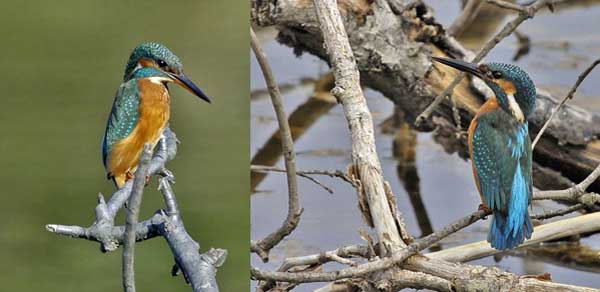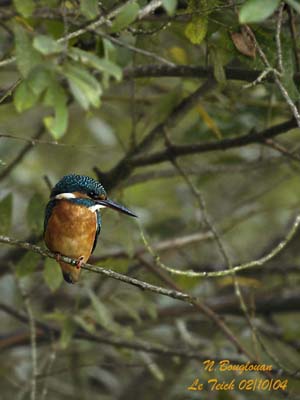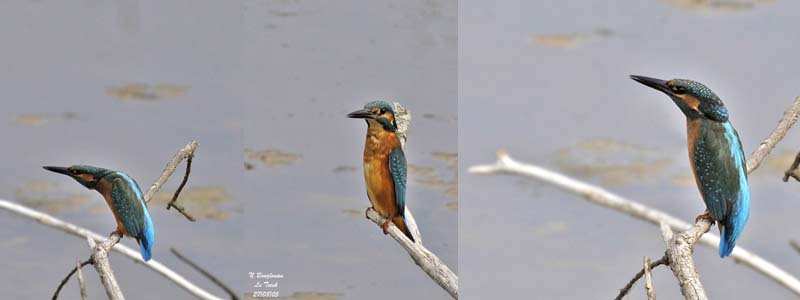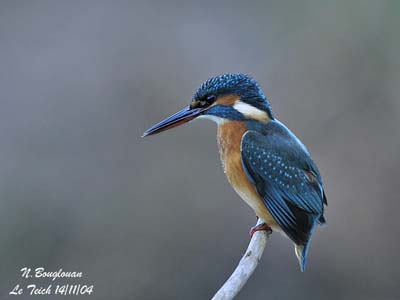
Common Kingfisher
Alcedo atthis
Coraciiforme Order - Alcedinidae Family
BIOMETRICS :
Length : 16 cm ; Weight : 23-25 g
DESCRIPTION:
Common Kingfisher has wide range, where several subspecies are living.
Adult male has turquoise-green upperparts with brighter turquoise rump. Tail is blue. Wings are darker blue, finely spotted with turquoise on greater coverts.
The underparts are rufous-orange, slightly darker on flanks.
On the head, crown and malar stripe are blue, finely spotted with paler blue and black. Lores and ear-coverts are rufous-orange. We can see a black eye-stripe. Chin, throat and neck-sides are white.
The long, pointed bill is dark. Eyes are dark brown. Legs and feet are bright orange.
Female is similar to male, except for the bill where the lower mandible is orange.

Juvenile is duller than adults, greener on the upperparts and paler below, with greyer legs.
The Common Kingfisher has several subspecies which differ in size and colour intensity.
VOICE: SOUNDS BY XENO-CANTO
The Common Kingfisher utters short, shrill, high-pitched “seep-seep” when flying. The alarm call is a harsh “tjiii”. When threatened, it gives grating “kritritrit”. We can hear other kinds of calls such as “tei titi titi titi” as advertising call.
The song includes whistles and warblers.

HABITAT:
The Common Kingfisher lives in quiet waters with vegetation on the shores such as reeds and shrubs for perches, and small fishes for feeding. It may be found along streams of all kinds, lakes and ponds.
It needs suitable banks during the breeding season for nesting.
It tends to be more coastal in winter, and may be seen in estuaries, rocky seashores and harbours.
Populations living in tropical regions frequent mangroves, swamps, wet grasslands and rivers with dense vegetation on banks.
RANGE:
The Common Kingfisher is widely present in Europe and Asia. It is also found in North Africa where it is winter visitor.
BEHAVIOUR:
The Common Kingfisher feeds mainly on fishes, taken from perches above the water. The bird waits for long moments, watching for preys by turning and bobbing head and body. When the prey is detected, it dives steeply and catches the fish under water, at about one metre in depth. Then, using its wings, it propels itself and raises bill first and returns to its perch.

It holds the fish near the tail and beats it against the perch, and then, it turns the fish and swallows it head first.
Common Kingfisher also hovers above the water if any perch is available, and then, it dives.
It also takes insects in flight.
It regularly regurgitates pellets with fish bones and hard parts of insects.
While diving, the eyes are protected from the water by a membrane.
The Common Kingfisher is usually solitary. It is territorial because it needs food enough every day. The territory is strongly defended from other species, but also from mates and youngs.
There is a ritual display showing the birds perched separately, and displaying feathers and beaks, while they utter whistles. Usually, there is not combat, but sometimes, the birds may fight.
They call in flight and display from perches, crouching and stretching, the body swaying from side to side. They also may sit upright with the neck outstretched and wings dropped. Then, the intruder is chased away from the territory.

The populations of Common Kingfishers of the northern parts of the range migrate southwards in winter because waters are freezing, preventing to fish.
The southern populations are sedentary.
During the breeding season, it is monogamous and solitary nester. Female receives food from the male before the copulation, usually a fish.
FLIGHT:
Common Kingfisher performs low, direct flight. It hovers above the water for fishing.

REPRODUCTION:
The breeding season varies according to the location.
Common Kingfisher nests in sandy banks along streams. Occasionally, it may use a hole in wall or in rotten tree stump, or in termite mound.
It digs a tunnel with a nest chamber at the end. Both sexes excavate the burrow of about 50 to 90 cm in length, and for that, they take turns.
The female lays 6 to 7 white eggs. Incubation lasts about 19 to 21 days, by both parents. Usually, female broods at night and both sexes during the day.
The youngs are fed by both adults and fledge in about 23-24 days or more. They perform their first dive four days later. They become independent very soon and leave the breeding territory.
This species produces one brood per season, sometimes two.

DIET:
The Common Kingfisher feeds mainly on fish and small crustaceans, prawns, crabs and others. It catches insects in flight.
PROTECTION / THREATS / STATUS:
The Common Kingfisher is widely distributed. The species is common in most parts of the range, but it is threatened by river pollution, human developments and disturbances.
Fr: Martin-pêcheur d’Europe
All : Eisvogel
Esp : Martín Pescador Común
Ital: Martin pescatore comune
Nd: Ijsvogel
Russe: Зимородок
Sd: Kungsfiskare
Artwork at the top of the page by Francisco José Hernández
His website:
AVESTRAZOS
Photographs and text by Nicole Bouglouan
More photographs: PHOTOGRAPHIC RAMBLE
Sources :
HANDBOOK OF THE BIRDS OF THE WORLD Vol 6 by Josep del Hoyo-Andrew Elliott-Jordi Sargatal - Lynx Edicions, 2001 - ISBN: 848733430X
Sungei Buloh Wetlands Reserve (Michael Mastaller)
Wikipedia (Wikipedia, The Free Encyclopedia)
